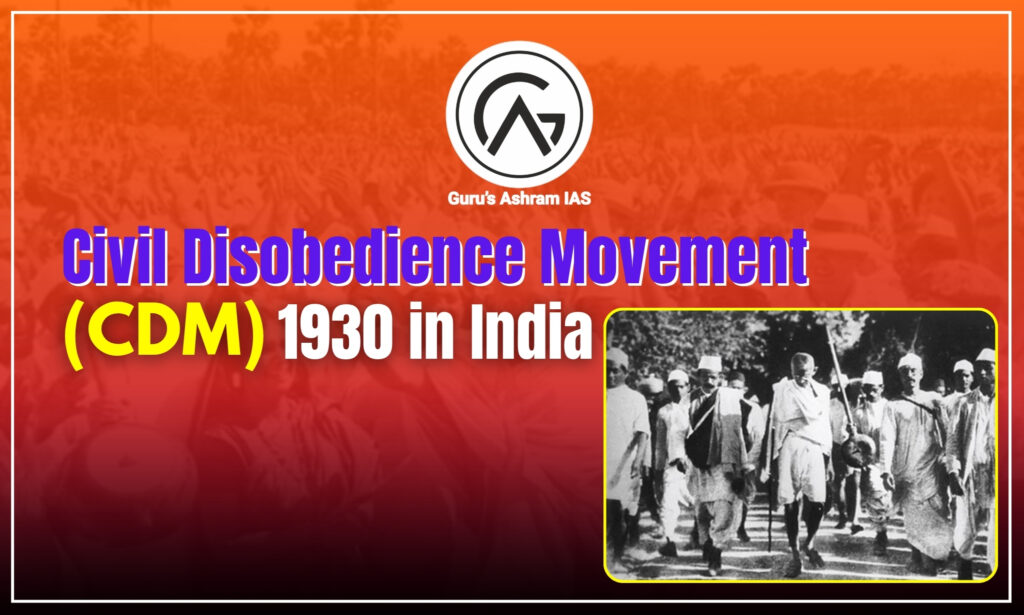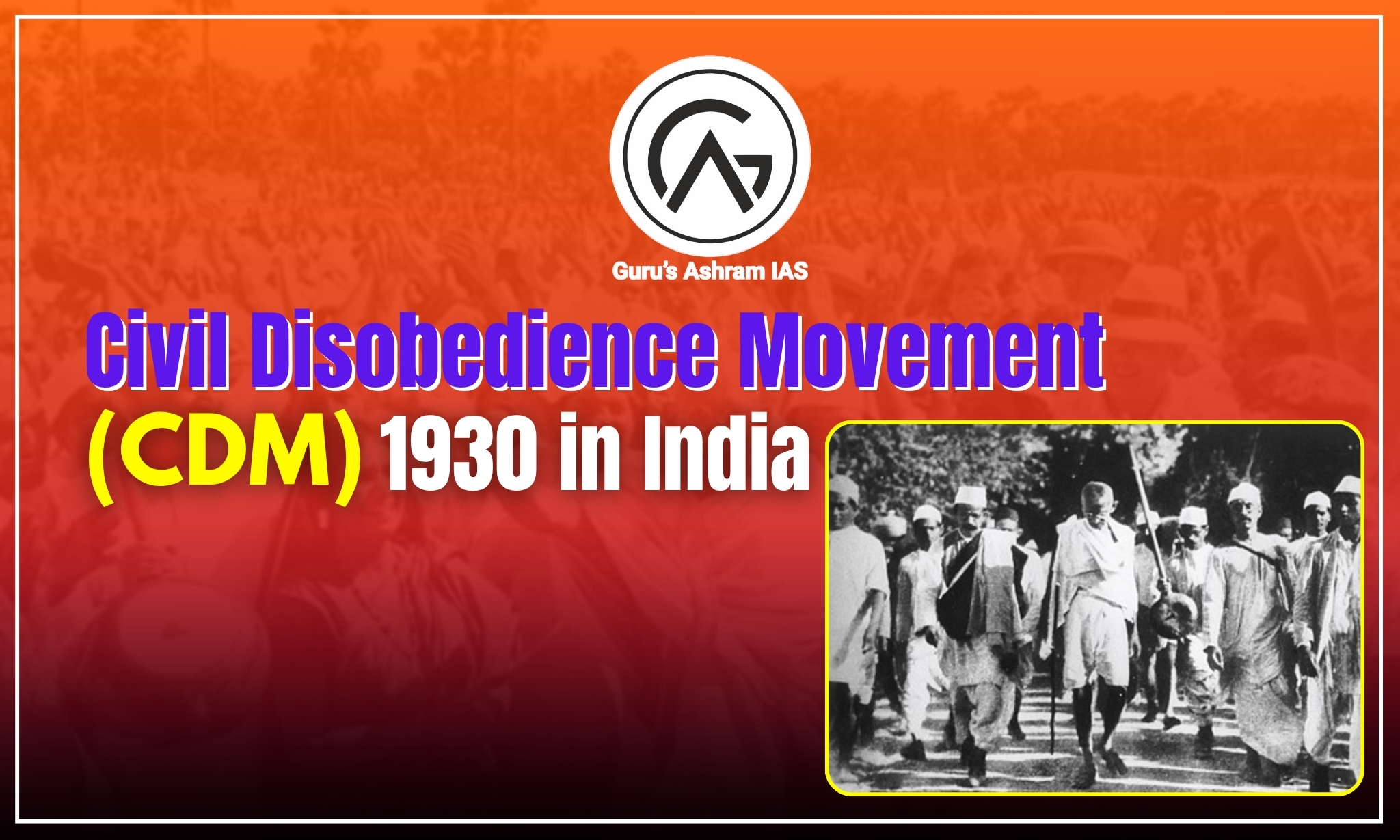Civil Disobedience Movement And Non Cooperation Movement In India
Salt and Courage: India’s 1930 Fight for Freedom
Imagine India in 1930, where every pinch of salt you sprinkle on your roti comes with a British tax, a bitter reminder of an empire that takes your labor and leaves you with crumbs. Your fields grow cotton for London’s mills, but your kids go to bed hungry. Freedom is a dream whispered in every village, heavy under the weight of colonial rule. Then comes Mahatma Gandhi, a thin man in a plain dhoti, with a plan so bold it feels like a fire in the night: walk to the sea, make salt, and tell the British their laws are nothing. That simple act kicked off the Civil Disobedience Movement (CDM), or Savinay Avagya Aandolan, a fight without guns that shook the British Raj. With the Dandi Salt March as its heart, the Civil Disobedience Movement 1930 in India saw millions—farmers, women, students, traders, and tribal folk—stand up to break unjust laws, burn British cloth, and refuse taxes. Let’s dive into the Civil Disobedience Movement 1930, its roots, its spread, its wins, its struggles, and its lasting spark, ideal for Civil Disobedience Movement Class 10 lessons, UPSC preparation, or a CDM Movement Summary.
-
Daily Quiz Telegram Channel: Click to Join
-
Guru’s Ashram IAS Telegram Group: Click to Join
-
Click To Join Guru’s Ashram IAS Official Whatsapp Channel :- (https://whatsapp.com/channel/0029Va68jla0AgW6JrNUzb44)
-
Click To Join Our Telegram Group Click Here:- ( https://t.me/gurusaashram )
-
Click To Join Our Whatsapp Group Click Here:- ( https://chat.whatsapp.com/J4HYp7p6jFa0wOpA644Sur )
Click Here To Call us now!
Enquiry Here, Fill this form & Ask the Questions
What Lit the Fire: Causes of Civil Disobedience Movement
By the late 1920s, India was ready to explode. Years of British greed, fresh insults, and big dreams of freedom had people ready to fight. Here’s what set the Civil Disobedience Movement in India in motion, key for Civil Disobedience Movement Notes.
Tough Times, Broken Lives: The Great Depression’s Hurt
When the Great Depression struck in 1929, it didn’t just rattle America—it crushed India’s villages. Farmers growing jute and cotton for British markets found no takers, their earnings gone. Rice, oil, and cloth cost a fortune, but wages stayed stuck. Worst of all, the British taxed salt, something every family needed. In a village in Bengal, a farmer named Bimal sold his last cow to pay the salt tax, his wife weeping as hunger loomed. This hardship, a major cause of Civil Disobedience Movement, turned quiet pain into a loud cry for justice, a must-know for Civil Disobedience Movement UPSC study.
A Kick in the Face: The Simon Commission’s Insult
In 1929, the British sent the Simon Commission to “fix” India’s government, but it was a slap: seven British men, not one Indian. It said, “You don’t get a say.” From Delhi’s crowded lanes to Madurai’s temple streets, people spilled out, waving black flags and yelling, “Simon, go back!” In Lahore, a shopkeeper named Tara joined the chants, her hands shaking with anger. This outrage, another cause of Civil Disobedience Movement, brought Indians together, a spark for the Civil Disobedience Movement 1930 in India.
Hopes of a Better World: Revolution’s Whisper
The 1920s were alive with new ideas. Socialism and communism got farmers and workers dreaming of a fairer life. Young firebrands like Bhagat Singh, part of the Hindustan Socialist Republican Association, thrilled people by tossing bombs in the British Assembly—not to kill, but to shout, “Enough!” News of uprisings, like Russia’s revolution and Ireland’s freedom, hinted that empires could fall. In Bombay’s dockyards, a porter named Hari shared tales of Gandhi’s fight, his third cause of Civil Disobedience Movement fueling the Savinay Avagya Aandolan.
A Win to Believe In: Bardoli’s Bold Stand
In 1928, something special happened in Bardoli, Gujarat. Farmers, led by Sardar Vallabhbhai Patel, refused to pay sky-high taxes, using Gandhi’s satyagraha—standing strong without fighting. They won, and the British backed off. A young boy, Nilesh, watched his father hide crops from taxmen, his chest puffed with pride. This victory showed nonviolence could work, inspiring the Civil Disobedience Movement in India, a key point for Civil Disobedience Movement 1930 Notes.
A Dream Declared: Poorna Swaraj’s Vow
At the 1929 Congress meeting in Lahore, with Jawaharlal Nehru leading, a bold call went up: “We want Poorna Swaraj—full independence.” No more settling for “Dominion status” where Britain still ruled. On January 26, 1930, from dusty hamlets to bustling towns, Indians swore to fight for total freedom. In a Rajasthan village, a midwife named Ganga led the pledge, her voice steady. This oath marked the Civil Disobedience Movement Date and answered Savinay Avagya Aandolan Kab Hua, vital for Civil Disobedience Movement Class 10.
Gandhi’s Challenge: Demands Denied
Gandhi didn’t mince words. He sent Viceroy Lord Irwin eleven demands—lower taxes, end the salt tax, free jailed patriots. These spoke to everyone, from peasants to merchants. When Irwin ignored them, Gandhi stood firm, saying, “We’ll claim our rights.” In a letter, he wrote, “Our fight is with courage, not hate.” This rejection lit the fuse for the Civil Disobedience Movement 1930, a cornerstone for CDM Movement PDF and UPSC study.
A Walk That Woke the World: Dandi Salt March and Civil Disobedience Definition
On March 12, 1930, Gandhi set out from Sabarmati Ashram with 78 followers, bound for Dandi, a coastal village 240 miles away. For 24 days, they walked through Gujarat’s sun, stopping to talk of freedom under village trees. Crowds grew—farmers, mothers, kids—until thousands marched as one. On April 6, 1930, Gandhi reached Dandi, knelt by the sea, and scooped up salt, breaking the British Salt Law. That law taxed a daily need, a mark of British greed. Gandhi’s act showed civil disobedience—peacefully breaking unjust laws, a civil disobedience definition rooted in satyagraha. He called it “a small step to a big dream.” The Dandi Salt March, the heart of the Civil Disobedience Movement 1930 in India, set India ablaze, praised worldwide and key for Civil Disobedience Movement Notes.
India Says No: The Civil Disobedience Movement in India Spreads
The Dandi March was like a spark in dry fields, and the Civil Disobedience Movement in India caught fire. From quiet villages to noisy cities, people found ways to resist, making the CDM a people’s fight, perfect for a CDM Movement in India Essay.
Salt Turns to Rebellion: Defying the Raj
After Dandi, making salt was a way to say no. In Tamil Nadu, C. Rajagopalachari led a march to Vedaranniyam, cooking salt as British soldiers watched. In Bengal, an old man named Kalu sold homemade salt in his market, daring arrest. Even in landlocked Punjab, people bought smuggled salt. This wasn’t about needing salt—it was about shouting, “You don’t control us.” Each grain was a win, a story for Civil Disobedience Movement 1930 PDF and CDM Movement Summary.
Burning British Rule: Boycotts Blaze
British cloth went up in flames from Agra’s bazaars to Calicut’s shores. People stood outside liquor shops, urging others to reject British goods. Indians spun khadi on charkhas and bought local. Merchants in Gujarat and Calcutta, led by figures like G.D. Birla, cut British trade. In Baroda, a trader named Shyam burned his stock, saying, “This is my freedom.” This hit Britain’s wallet, a key impact of Civil Disobedience Movement for UPSC and Class 10.
Cutting the Raj’s Lifeline: No Taxes Paid
Villagers stopped paying land taxes and chowkidari taxes, fees for watchmen who served British interests. In Gujarat, some fled to princely states like Bhopal. In Bihar, a farmer named Ram refused rent, facing soldiers but not budging. In Uttar Pradesh, whole villages joined the no-rent fight. This choked British funds, a bold move in the Civil Disobedience Movement in India, per CDM Movement Notes.
Women Lead the Way: The Fight’s Soul
Women were the CDM’s spirit, a highlight for Civil Disobedience Movement Class 10. They picketed shops, marched in the heat, and spun khadi. Sarojini Naidu and Kamala Nehru rallied thousands. In Madras, a mother named Vani joined her first protest, her heart racing. Their courage broke old rules, showing freedom was for all, key for Civil Disobedience Movement in Hindi and CDM Movement PDF.
Brave Hearts Everywhere: Local Heroes Unite
The CDM was a patchwork of courage. In Peshawar, Khan Abdul Ghaffar Khan led his Khudai Khidmatgars in peaceful defiance, their red shirts bold. In Sholapur, workers ran their own town for days. In Nagaland, young Rani Gaidinliu led tribal resistance, jailed but unbroken. From Subhas Chandra Bose in Bengal to K. Kelappan in Malabar, local leaders made the Civil Disobedience Movement 1930 in India a national dream, vital for CDM Movement UPSC.
Strength in Silence: Dharasana’s Stand
After Gandhi’s arrest in May 1930, the CDM grew fiercer. On May 21, Sarojini Naidu led a march to the Dharasana Salt Works. Hundreds walked, unarmed, in rows. British police charged, swinging batons, blood staining the sand. None fought back, showing peaceful civil disobedience. American reporter Webb Miller watched, writing, “I saw bravery like never before.” His stories, read in London and New York, turned the world against Britain, a key moment for Civil Disobedience Movement 1930 Wikipedia and CDM Movement Summary.
Wins That Changed History: Impact of Civil Disobedience Movement
The Civil Disobedience Movement 1930 wasn’t a quick protest—it left deep scars on British rule and shaped India’s path, ideal for Civil Disobedience Movement UPSC and Class 10 Notes.
Hitting Britain’s Pockets: Economic Damage
The British needed India’s taxes to run their empire. When cloth and liquor sales fell, their profits sank. Land taxes and fees dried up, costing millions in 1930–31. In Bombay, a British official said, “They’re draining us.” This economic blow, a major impact of Civil Disobedience Movement, proved Britain wasn’t invincible, per CDM Movement in India Notes.
A Bigger Fight: India Stands Together
The CDM brought women, merchants, farmers, and tribals into one fight. In Orissa, a fisherman named Madan led a salt protest. Farmers in Bihar formed Kisan Sabhas. Students left schools. This unity strengthened the Congress, a key impact of Civil Disobedience Movement for UPSC and Class 10.
The World Sees India: Global Friends
Dharasana’s brutality shocked the world. Webb Miller’s reports, in over 1,000 papers, showed Britain’s cruelty. In America, a preacher named John Haynes Holmes called Gandhi “a hero.” The CDM inspired places like Ghana and Indonesia, a global impact of Civil Disobedience Movement, per Civil Disobedience Movement 1930 PDF.
Talking to Power: Political Gains
The CDM forced Britain to act. On March 5, 1931, the Gandhi-Irwin Pact freed prisoners and allowed salt-making. Gandhi paused for the Second Round Table Conference in London. The talks failed, but the pact showed mass action worked, a win for Civil Disobedience Movement 1930 UPSC and CDM Movement Notes.
A Spark That Still Shines: Why the CDM Matters
The Civil Disobedience Movement 1930 didn’t end British rule, but it changed India’s fight and the world, key for Civil Disobedience Movement in India PDF.
Showing Britain’s Greed: The Salt Tax Exposed
The salt tax was a cruel sign of British profit-hunger. Breaking the Salt Law, the CDM showed their true aim: money. In a Gujarat village, a father named Dev told his kids, “This salt is ours.” This truth united India, per Civil Disobedience Movement Notes.
Nonviolence’s Might: Satyagraha Wins
Gandhi’s satyagraha—truth and peace—was the CDM’s soul. Dandi and Dharasana showed nonviolence could beat force, a civil disobedience definition that inspired US history movements. Gandhi said, “Our power is our heart.” This strength, per Civil Disobedience Movement in Hindi, changed the world.
India as One: Unity’s Power
The CDM joined farmers, traders, women, and students. In Assam, tribal women marched with city students in Kanpur. Not everyone joined, but it showed India’s strength, per Civil Disobedience Movement Class 10.
Paving Freedom’s Path: A Strong Step
The CDM made Congress stronger, set Poorna Swaraj as the goal, led to 1937 election wins, and prepared for Quit India in 1942. Every step to 1947 had CDM’s mark, per CDM Movement UPSC.
Lighting the World: Global Hope
The CDM inspired Martin Luther King Jr.’s 1963 marches, a civil disobedience definition US history link. Nelson Mandela, Ho Chi Minh, and Aung San drew from it. It’s a lesson for today’s fights, per Civil Disobedience Movement 1930 Wikipedia.
Rough Roads: Limits of Civil Disobedience Movement
The CDM was bright, but it hit bumps, key for Civil Disobedience Movement UPSC and Class 10.
Freedom Waits: No Fast Win
The British didn’t leave. Over 90,000 arrests, including Gandhi’s, weakened the CDM by 1934. In Punjab, a protester named Amar said, “We fought hard, but freedom’s not here.” This is a limit of Civil Disobedience Movement, per CDM Movement Summary.
Not All Together: Missing Voices
Muslims, drawn to the Muslim League, joined less, wary of tensions. Dalits, led by Dr. B.R. Ambedkar, wanted caste justice. He said, “Freedom must help everyone,” a limit of Civil Disobedience Movement, per Civil Disobedience Movement Notes.
A Hard Price: Boycotts Hurt Home
Boycotts hit Britain but also Indian traders. In Delhi, a weaver named Kailash sold his loom to eat, torn between pride and hunger, a limit of Civil Disobedience Movement, per Class 10.
Different Dreams: Divided Paths
Gandhi’s peace didn’t suit rebels like Bhagat Singh, hanged in 1931, who said, “I want a storm.” Ambedkar focused on equality. These splits hurt unity, per Civil Disobedience Movement 1930 UPSC.
Peace Broken: Violence Slips In
The CDM aimed for peace, but fights in Sholapur and Chittagong’s armory raid hurt its image, a limit of Civil Disobedience Movement, per CDM Movement PDF.
A Break, Not an End: Gandhi-Irwin Pact and Beyond
On March 5, 1931, the Gandhi-Irwin Pact paused the CDM. Britain freed prisoners and allowed salt-making; Gandhi went to London for talks. The talks failed, and the CDM restarted in 1932 but faded after Gandhi’s January arrest. It stopped in May 1933, ending in April 1934. Gandhi said, “We rest to fight again,” per Civil Disobedience Movement 1930 Notes.
Two Fights, One Goal: Non-Cooperation Movement vs. Civil Disobedience Movement
The Non-Cooperation Movement (NCM) of 1920–22 set the stage for the Civil Disobedience Movement and Non-Cooperation Movement comparison, key for Class 10 and UPSC:
- What Started Them: NCM came from Jallianwala Bagh, Rowlatt Act, and Khilafat. CDM followed the Simon Commission, Depression, and Poorna Swaraj.
- How They Fought: NCM used boycotts; CDM broke laws like the Salt Tax.
- Who Joined: NCM had Muslim support via Khilafat; CDM saw women and traders but fewer Muslims.
- How They Ended: NCM stopped after Chauri Chaura; CDM paused with the Pact.
- What They Did: NCM spread hope; CDM forced talks, per Non-Cooperation Movement Year and CDM Movement Summary.
The CDM was fiercer, per Civil Disobedience Movement Class 10.
A Flame That Never Fades: The CDM’s Legacy
The Civil Disobedience Movement 1930 didn’t free India, but it changed everything. Subhas Chandra Bose called Dandi as bold as Napoleon’s return. A handful of salt showed civil disobedience could shake empires. It united millions, from Gujarat’s shores to Manipur’s hills, and inspired global fights. By 1947, the CDM was a foundation. For UPSC, its strategy is key; for Class 10, it’s a story of courage. In Hindi, Savinay Avagya Aandolan is about himmat (courage) and ekta (unity). Its light still guides, per Civil Disobedience Movement in India PDF and CDM Movement in India Essay.
Extra Glimpses: The CDM’s Bigger Picture
- Economic Genius: The CDM hit Britain’s cash flow, with the salt tax worth £25 million yearly. For UPSC, this shows Gandhi’s smarts.
- Cultural Pride: The CDM revived swadeshi, with khadi a symbol of freedom, still alive in India’s handlooms.
- Future Splits: Less Muslim involvement foreshadowed the 1940s’ divide, key for Class 10 and UPSC.
- Worldwide Waves: Beyond King and Mandela, the CDM inspired Ghana’s Kwame Nkrumah, tying India to global freedom fights.






